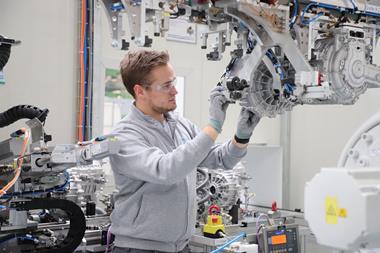
Raffaello Lepratti, vice-president of business development and marketing at Siemens, outlines the company’s SIMATIC IT Preactor planning and scheduling solution
 Car buyers’ tastes are becoming more diversified. They are attracted by design and performances, but also by region-specific features and a touch of uniqueness. Cars are one of the few mass products that are individually configured and sold. Another driver of change in the automotive industry is the global emission standards that are forcing a new level of innovation for engineering and manufacturing to meet government mandates. Engine control strategies are evolving with more parameterisation, while emission-testing revisions will also affect other components. A third driver is the fact that OEMs are examining cost-reduction strategies, such as the adoption of shared platform and modular systems, allowing them to save money while also enhancing production flexibility.
Car buyers’ tastes are becoming more diversified. They are attracted by design and performances, but also by region-specific features and a touch of uniqueness. Cars are one of the few mass products that are individually configured and sold. Another driver of change in the automotive industry is the global emission standards that are forcing a new level of innovation for engineering and manufacturing to meet government mandates. Engine control strategies are evolving with more parameterisation, while emission-testing revisions will also affect other components. A third driver is the fact that OEMs are examining cost-reduction strategies, such as the adoption of shared platform and modular systems, allowing them to save money while also enhancing production flexibility.
These changes raise crucial questions regarding demand predictions and design planning, as well as the risks involved in following technological trends. Recent analysis in the automotive market indicates agility strategies and capacity management will be key competitive differentiations between carmakers and their production facilities. Existing tools, such as spreadsheets, are not suitable to face market challenges.
Connecting the dotsProduction scheduling is intrinsically very complex due to the high number of possible different variants, even with few numbers of items to produce. It is even more complicated in the automotive industry due to the peculiarity of its supply chain, where lean and agile manufacturing strategies cooperate and integrate. In addition, OEMs and suppliers often have different production approaches, with the latter focused on customisation while the former aims for standardisation. This means that collaboration may be tough, and having a reliable prediction of production may be challenging.
Traditionally, two possible approaches to production scheduling in automotive have been present: spreadsheets and advanced planning with scheduling (APS) systems. Spreadsheets are a digitalised version of the first scheduling boards drawn on paper, and they often incorporate several algorithms, but even the more complex ones cannot provide important features, such as: connectivity to another system (unless complex and costly implementations are used) to import and export data; distribution and collaboration among different users – each spreadsheet is a standalone application and therefore collaborative scheduling is not possible; automatic synchronisation with execution to keep up to date.
APS systems optimally allocate production capacity to meet demand. They are especially well suited to environments where simpler planning methods cannot adequately address complex trade-offs between competing priorities, and where response time against production deviation is crucial.
A big challenge for scheduling in the automotive industry is that delivery date of remotely assembled parts is subject to change and adjustment. Therefore, OEMs must often schedule based on expected lead-time. There are often disturbances that invalidate the scheduling, such as delays in material supply, changes in customer orders, unexpected manufacturing issues, defects and unavailability of resources. This makes it very difficult for the subsequent processes to adhere to planned delivery times. In case of deviation, such as the ones described above, time is crucial and it is mandatory to reschedule as quickly as possible; nevertheless, it is difficult to quickly understand the production scenario and identify any impact on productivity, efficiency and due dates. This is because manual scheduling and keeping it up to date is a time consuming task, requiring synchronisation of different data (raw materials stock levels, resources availability, supply date and order due dates). When more than one option is available, it is also difficult to compare them and evaluate which one performs better (the so called ‘what-if’ analysis).
In such a situation, a spreadsheet-based solution often fails. As a result, it is helpful to have a better tool, such as an APS, which keeps the schedule up to date and allows for speedy evaluation and comparison between possible alternatives that aim to keep delivery time as promised. Or if this is not possible, a tool that allows companies to understand and inform all affected parties of production scheduling changes.
Digitalisation and a holistic planning and scheduling approach are key elements that can bring companies benefits and affect value drivers. Improvements can be delivered to the manufacturing environment, including better alignment and synchronisation among the various business levels, greater collaboration and visibility among business roles.
The right systemThe Siemens solution for planning and scheduling is SIMATIC IT Preactor APS. This collection of software offerings comprises Advanced Planning (AP) and Advanced Scheduling (AS) products. SIMATIC IT Preactor AS allows companies to gain greater visibility and understanding of manufacturing processes, and thereby obtaining more control of those processes. It enables better machine utilisation, on-time delivery, impact analysis of ‘what if’ scenarios, and identification of bottlenecks to give a few examples. SIMATIC IT Preactor AS is also suited to non-manufacturing environments, given that the principles of resource constraints apply across many industry sectors.
For companies that are in a volatile, make-to-stock environment and require a more dependable method to plan capacity and stock, SIMATIC IT Preactor AP offers a planning tool that has the convenience and flexibility of spreadsheets but with interactive graphs to give the user full control over the results. And unlike spreadsheets and other applications that are typically relied upon, SIMATIC IT Preactor is suitable for use with large amounts of data, supports both constrained and unconstrained production, and provides a tool to perform ‘what if’ calculations with alternative scenarios that can deliver true-cost reductions.
SIMATIC IT Preactor has great flexibility: it is natively integrated with other Siemens products, being part of the Siemens solution for Manufacturing Operation Management, and can easily receive data from existing systems or to be entered within the application. For these reasons, it is suitable to be both part of a fully integrated solution from PLM to Automation (leveraging on the unique opportunities provided by Siemens portfolio) or added to an existing system to provide the APS functionalities that companies need. It can support all types of manufacturing processes with off-the-shelf capability.
SIMATIC IT Preactor use cases
A manufacturer of crankshafts and camshafts in the automotive industry was faced with several challenges, including:• Balancing finished stock to meet delivery deadlines• Reducing lead-time and work in process• Replacing the spreadsheets to gain agility
By using SIMATIC IT Preactor, the company was able to:• Increase on-time delivery performance by 50%• Increase productivity by 25%• Reduce lead-time by 40%• Reduce WIP by 15%• Reduce working space (area to hold materials) by 30%
Another manufacturer in the automotive industry, this time of interior components, wished to fully automate pre-assembly lines with complex integration and direct connection to supervision. By using SIMATIC IT Preactor, it was able to:• Carry out agile decision-making with increased visibility• Reduce time to reschedule by 50%• Reduce line setup time by 20%• Reduce time to schedule for new orders• Automatically campaign generation (min/max)
Siemens Manufacturing Operations Management (MOM) software is a holistic solution that enables you to implement your strategy for the complete digitalisation of manufacturing operations. Our portfolio provides end-to-end visibility into production, allowing decision-makers to readily identify areas to be improved within both the product design and associated manufacturing processes, and make the necessary operational adjustments for smoother and more efficient production.Our products provide solutions for:• Advanced planning and scheduling• Manufacturing execution• Quality management• Manufacturing intelligence
































